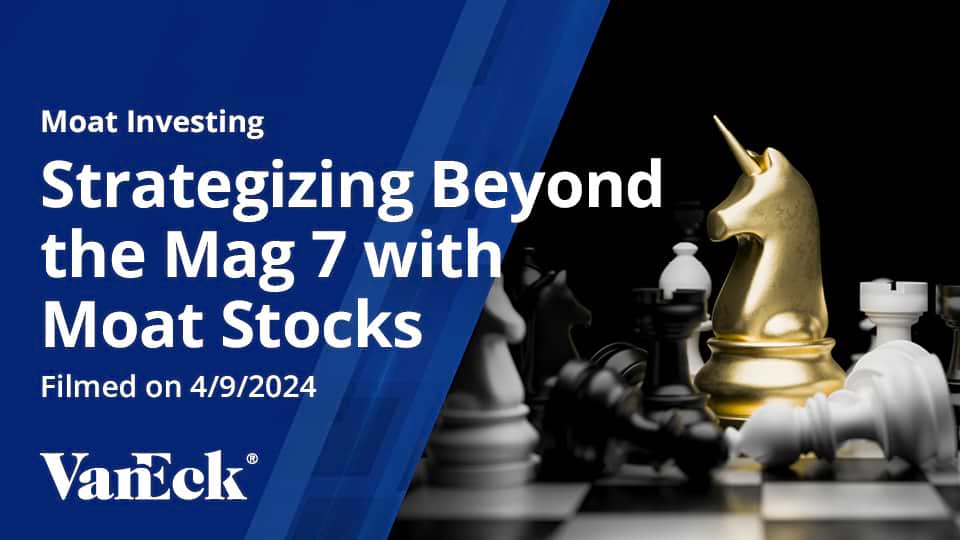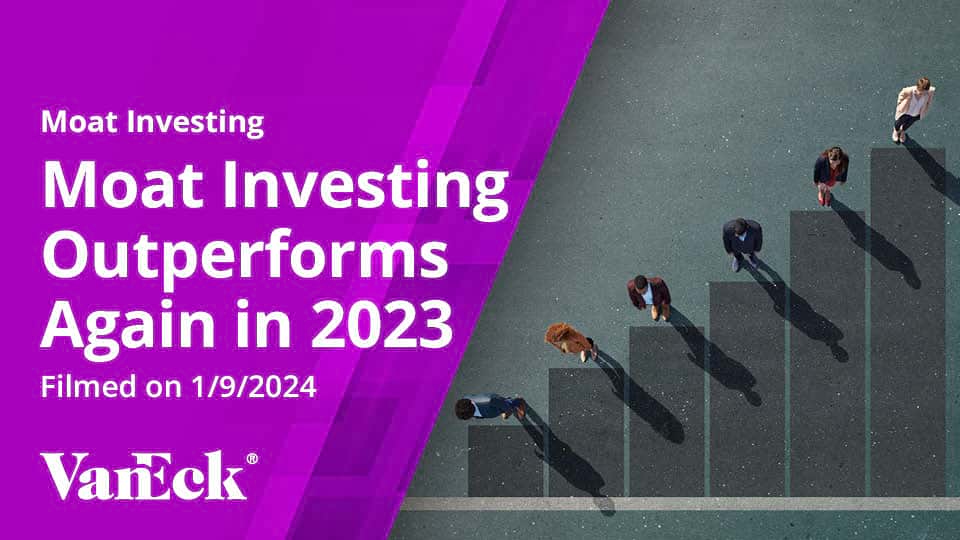Moat Investing: The Value Tilt in Context
07 April 2021
Watch Time 5:22 MIN
Jenna Dagenhart: Joining us to share more about how moat strategies work, and the transition to value is VanEck's Senior ETF Product Manager, Brandon Rakszawski. Brandon, how does a moat strategy fit into the portfolio, and how has this strategy performed compared to the broader market?
Brandon Rakszawski: Our VanEck Vectors Morningstar Wide Moat ETF fits really in the core of an equity allocation within a portfolio. It tends to be a large blend strategy, and it historically has been. It's a very unique strategy, but also very simple when you look under the hood. It's simple in the sense that the underlying index that MOAT (the ticker symbol for the ETF) is seeking to track seeks to identify companies with sustainable competitive advantages, but also seeks to identify those that are trading at attractive prices relative to their fair value.
Brandon Rakszawski: So, very simple. Find great companies with competitive advantages, and identify those that are attractively priced and allocate to them on a quarterly basis. Where it's unique within the marketplace is that the underlying index is leveraging Morningstar equity research’s 100-person plus analyst team and their output—their economic moat ratings and their fair value assessment—in order to assemble a portfolio of wide moat companies that are trading at an attractive valuation.
Brandon Rakszawski: Whereas most index-based strategies in the ETF marketplace may be using quantitative, backward-looking data to assemble a differentiated index, with the hopes of outperforming in the future, this strategy is leveraging forward-looking equity research by an extensive global equity research team with a proven track record. The underlying index and the ETF have performed very well, historically, relative to the broad U.S. equity markets as represented by an index like the S&P 500 over the five-year period, ending on March 31. And the ETF itself has outperformed the S&P 500 Index by nearly 3.5%.
Brandon Rakszawski: And in the near term, in the first quarter of 2021, the ETF and the underlying index nearly doubled the performance of the S&P 500 index—just under 12% for the ETF and index, where the S&P was just over 6%. So, it's off to a strong start this year, and a lot of that has to do with the positioning of the portfolio that we've seen over the last year or so.
Jenna Dagenhart: Yeah, let's talk a little bit more about your positioning. The moat strategy is not a traditional value strategy, yet you have a large exposure to value. Could you walk us through your process, some of the holdings in this transition to value?
Brandon Rakszawski: That's right. The underlying index certainly doesn't have a mandate. It's not a value strategy. It's not a growth strategy. It will simply identify opportunities based on valuations within the broader, wide moat universe. In 2020, as markets sold off amidst the pandemic turmoil, we did see the portfolio start to shift more and more toward value stocks. We saw financial companies, like Bank of America and others that have not been in the index for quite some time, start to enter, based on valuation opportunities. And Boeing would be another example. So, whereas the index may have had a growth bias in the past, currently it has a value tilt, and we believe it's positioned well for future success.
Jenna Dagenhart: Finally, Brandon, I won't ask you to predict the future here, but would love to get a sense of where you see this strategy headed from here? Anything interesting in the pipeline?
Brandon Rakszawski: Yeah, so as I mentioned, the quarterly reviews take place on a systematic schedule. That just occurred toward the end of March, and we didn't see a drastic pullback, from a style perspective, in value type of exposures. Whereas some of the strongest performing companies in the index started to lose that appeal from a valuation perspective and were removed from the portfolio—such as financials, or some of the large banks that were in the portfolio—the index is still positioned with a modest tilt toward value.
Brandon Rakszawski: So, we think that that's pretty well positioned moving forward, as we've seen a resurgence from cyclical stocks on the heels of hopeful economic recovery, leaving this pandemic shutdown environment. We'll see where it goes from here, but we're hopeful that the portfolio remains positioned to benefit from any future economic activity.
Jenna Dagenhart: Well, Brandon, great to have you. Thank you so much for joining us.
Brandon Rakszawski: You're welcome.
Jenna Dagenhart: And thank you for watching. That was VanEck's Senior ETF Product Manager, Brandon Rakszawski. To receive regular updates for VanEck's experts, please visit vaneck.com/subscribe. I'm Jenna Dagenhart with Asset TV.
IMPORTANT DISCLOSURE
Past performance is not a guarantee of future results. Performance may be lower or higher than performance data quoted. Please visit vaneck.com for performance current to the most recent month end.
The views and opinions expressed are those of the speaker and are current as of the video’s posting date. Video commentaries are general in nature and should not be construed as investment advice. Opinions are subject to change with market conditions. Information presented does not involve the rendering of personalized investment, financial, legal, or tax advice. Certain statements contained herein may constitute projections, forecasts and other forward looking statements, which do not reflect actual results, are valid as of the date of this communication and subject to change without notice. All performance information is historical and is not a guarantee of future results. Any discussion of specific securities mentioned in the video commentaries is neither an offer to sell nor a recommendation to buy these securities.
An investment in the Fund may be subject to risks which include, among others, investing in equity securities, consumer discretionary, consumer staples, financials, health care, industrials and information technology sectors, medium-capitalization companies, market, operational, index tracking, authorized participant concentration, no guarantee of active trading market, trading issues, passive management, fund shares trading, premium/discount risk and liquidity of fund shares, non-diversification and concentration risks, which may make these investments volatile in price or difficult to trade. Medium-capitalization companies may be subject to elevated risks.
Investing involves substantial risk and high volatility, including possible loss of principal. An investor should consider the investment objective, risks, charges and expenses of the Fund carefully before investing. To obtain a prospectus and summary prospectus, which contains this and other information, call 800.826.2333 or visit vaneck.com/etfs. Please read the prospectus and summary prospectus carefully before investing.
The S&P 500 Index is a product of S&P Dow Jones Indices LLC and/or its affiliates and has been licensed for use by Van Eck Associates Corporation. Copyright © 2021 S&P Dow Jones Indices LLC, a division of S&P Global, Inc., and/or its affiliates. All rights reserved. Redistribution or reproduction in whole or in part are prohibited without written permission of S&P Dow Jones Indices LLC. For more information on any of S&P Dow Jones Indices LLC’s indices please visit www.spdji.com. S&P® is a registered trademark of S&P Global and Dow Jones® is a registered trademark of Dow Jones Trademark Holdings LLC. Neither S&P Dow Jones Indices LLC, Dow Jones Trademark Holdings LLC, their affiliates nor their third party licensors make any representation or warranty, express or implied, as to the ability of any index to accurately represent the asset class or market sector that it purports to represent and neither S&P Dow Jones Indices LLC, Dow Jones Trademark Holdings LLC, their affiliates nor their third party licensors shall have any liability for any errors, omissions, or interruptions of any index or the data included therein.
No part of this material may be reproduced in any form, or referred to in any other publication, without express written permission of Van Eck Securities Corporation. © Van Eck Securities Corporation.
Van Eck Securities Corporation, Distributor
666 Third Avenue, New York, NY 10017
Related Insights
This material may only be used outside of the United States.
This is not an offer to buy or sell, or a recommendation of any offer to buy or sell any of the securities mentioned herein. Fund holdings will vary. For a complete list of holdings in VanEck Mutual Funds and VanEck ETFs, please visit our website at www.vaneck.com.
The information presented does not involve the rendering of personalized investment, financial, legal, or tax advice. Certain statements contained herein may constitute projections, forecasts and other forward looking statements, which do not reflect actual results. Information provided by third-party sources are believed to be reliable and have not been independently verified for accuracy or completeness and cannot be guaranteed. Any opinions, projections, forecasts, and forward-looking statements presented herein are valid as of the date of this communication and are subject to change without notice. The information herein represents the opinion of the author(s), but not necessarily those of VanEck.
The views contained herein are not to be taken as advice or a recommendation to buy or sell any investment in any jurisdiction, nor is it a commitment from Van Eck Associates Corporation or its subsidiaries to participate in any transactions in any companies mentioned herein. This content is published in the United States. Investors are subject to securities and tax regulations within their applicable jurisdictions that are not addressed herein.
All investing is subject to risk, including the possible loss of the money you invest. As with any investment strategy, there is no guarantee that investment objectives will be met and investors may lose money. Diversification does not ensure a profit or protect against a loss in a declining market. Past performance is no guarantee of future results.
Related Insights
09 January 2024



